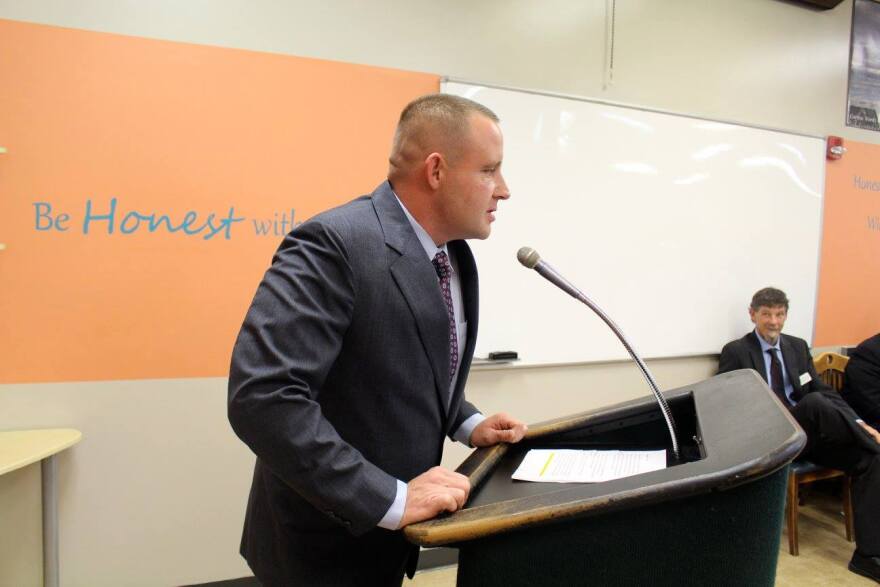By default, jails have long been where homeless addicts get clean if they run afoul of the law. But a new local partnership is connecting inmates for the first time with long-term recovery, saving taxpayers tens of thousands of dollars in the process. Reporter Jordy Yager has the story.
A year ago, 38-year old Brian Harden was running the streets. His biggest worry was how to get his next hit of crack cocaine. Back at home, his wife was worried sick.
“She would sit in her chair every night, instead of sleeping in her bed,” says Harden. “She was waiting for somebody to come home, knock on the door and say that your husband was dead.”
And so she called the cops on him. He had several outstanding warrants for check fraud. Police found him passed out in a parking lot with a crack pipe in his hand. He was arrested and taken to Chesterfield County jail, where he sat for three months, sobering up.
And normally, that’s where he would’ve stayed. But Harden was chosen to be one of the first inmates to benefit from a new partnership between the Sheriff’s Office and The Healing Place, the largest free recovery center in Virginia.
“It’s kind of a win-win situation for everybody,” says Lt. Stephen McCleod, the public information officer for the Sheriff’s Office, where he’s worked for 13 years. “We get them the help that either they couldn’t afford out on the street or that nobody would offer them.”
At the non-profit Healing Place, it costs private donors about $20 a day to pay for an addict’s long-term treatment. Compare that to the $115 it costs taxpayers daily to jail them. This new partnership leaves taxpayers on the hook for just $15 a day per inmate, which allows the Sheriff’s Office to track Harden’s location with a GPS ankle monitor.
“Rather than being incarcerated in the jail, which the cost would be higher, and then you still have that turnover effect, where they’re just coming in and out, in and out, repetitive, trying to sustain the habit, never breaking that cycle,” says McCleod.
And with a 70 percent success rate, breaking that cycle is exactly what The Healing Place is good at. It’s run by the homeless service provider CARITAS (Congregations Around Richmond To Assure Shelter).
Most of the 200 men at The Healing Place have experienced homelessness at some point because of their addiction. It’s an isolating experience, says Clara Stokes CARITAS’s chief development officer.
“The main thing that I've learned about what research is showing us is that the key to sobriety and long-term sobriety and recovery is connectedness,” says Stokes.
The Healing Place’s recovery program is based on the 12-steps and can take up to a year to complete. The men live in bunk beds, getting clean, attending dozens of classes, learning—many for the first time—about the nature of addiction. The “why” behind the disease. They also learn about the behavior, especially criminal, that accompanies addiction and how to change it.
Rob Hammond is a program supervisor at The Healing Place, and like much of the staff, he’s a recovering addict and program graduate.
“The obsession to drink, once I put a few drinks in me, that’s all my brain thinks about is drinking,” says Hammond. “And I’ll do anything or whatever I got to do to get it. My thinking then becomes irrational. And so if you lock me up, you’re not doing anything to treat my addiction.”
The main thing that I've learned about what research is showing us is that the key to sobriety and long-term sobriety and recovery is connectedness.
Hammond helps addicts through their lowest points. When they might snap and revert to the familiarity of addiction, Hammond’s there. He’s been through what they’re going through. Many have been abandoned by their families, their friends, their bosses. Here, they create a community and that community invests in them.
“My name’s Brian Harden, and I’m an alcoholic,” Harden tells a room filled with people.
“Hey Brian!” the crowd answers back.
Eight months after Harden walked through doors of The Healing Place, he stood alongside more than a dozen other men and graduated from the program’s recovery portion.
“I don’t let my past define who I am today,” Harden says to the audience. “I’ve lived a life I would not wish on my worst enemy. I’m really grateful for the Chesterfield County Jail, who’d have thought I’d ever say that.”
Standing before more than 200 of their friends and family, Harden stresses that now, the hard part begins. The men are entering into The Healing Place’s second program, called Works. It finds men jobs in the real world, where temptations, risks, and setbacks lurk behind every corner. For every 7 graduates who remain clean, 3 relapse into old habits.
“I got a long way to go,” Harden says. “And one thing I’ve got today that I know I haven’t had is a huge fellowship like I’ve got, and it’s going to continue to grow. And I need all y’all guys, I need all y’all. Thank you.”
After graduating, Harden got a job, moved back home with his wife, and was doing well, until he missed a probation meeting and went to jail for a few days. There he tested positive for drugs. He’s free again now, and sober. But he lost his job, and he’s on the outs with his wife, looking at possibly being homeless again.
Recovery, it seems, is not a destination, it’s a road.

